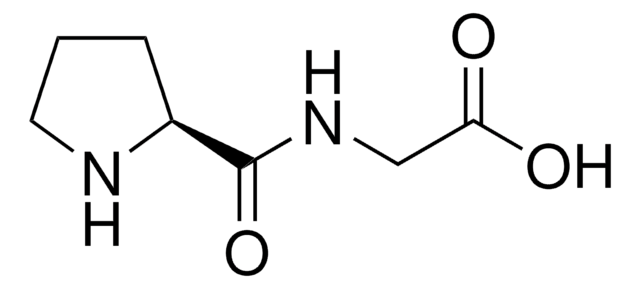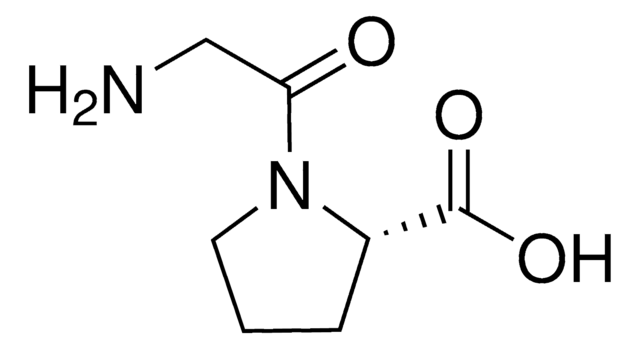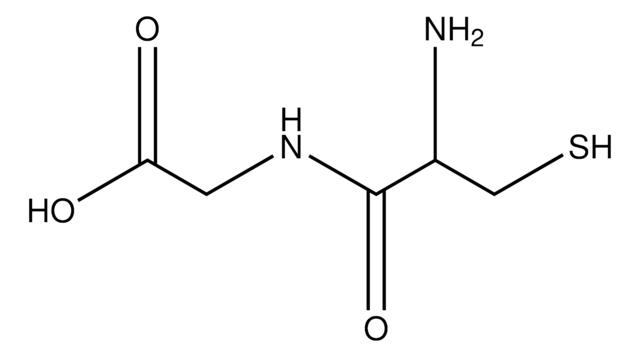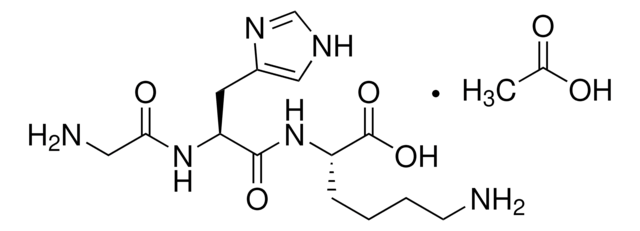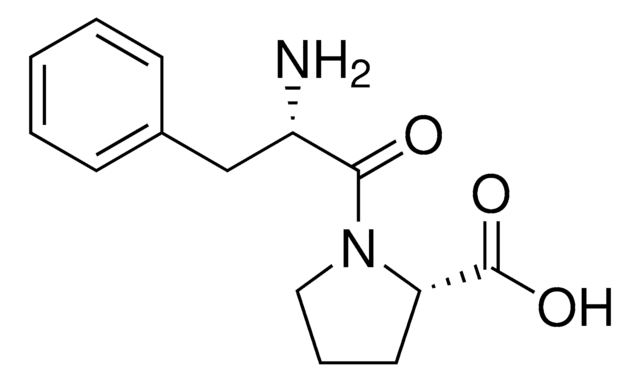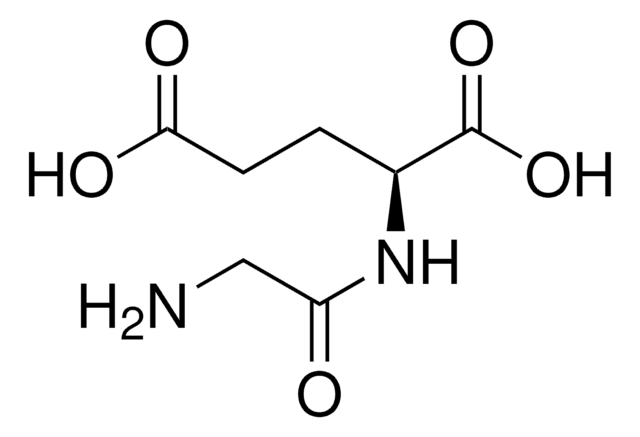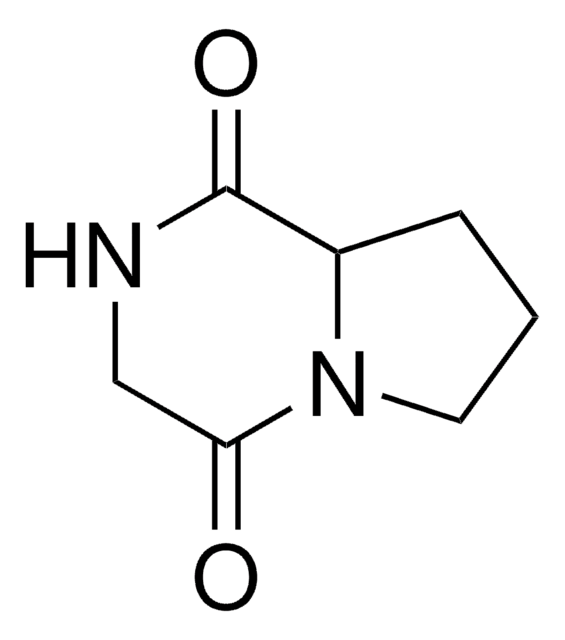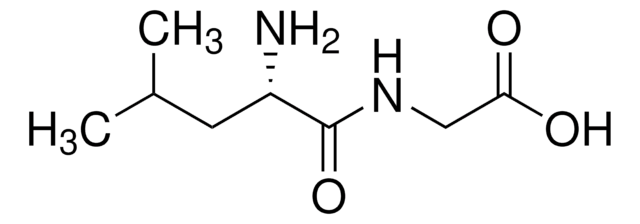全部照片(1)
About This Item
經驗公式(希爾表示法):
C12H19N3O6
CAS號碼:
分子量::
301.30
MDL號碼:
分類程式碼代碼:
12352209
PubChem物質ID:
NACRES:
NA.32
推薦產品
品質等級
化驗
≥98% (HPLC)
形狀
powder
顏色
white
儲存溫度
−20°C
SMILES 字串
NCC(=O)N1CCC[C@H]1C(=O)N[C@@H](CCC(O)=O)C(O)=O
InChI
1S/C12H19N3O6/c13-6-9(16)15-5-1-2-8(15)11(19)14-7(12(20)21)3-4-10(17)18/h7-8H,1-6,13H2,(H,14,19)(H,17,18)(H,20,21)/t7-,8-/m0/s1
InChI 密鑰
JJGBXTYGTKWGAT-YUMQZZPRSA-N
一般說明
IGF1 (insulin-like growth factor 1) protein is cleaved into des-N-(1-3)-IGF-1 and an N-terminal Gly-Pro-Glu (GPE tripeptide). It is thought to be an outcome of specific neural processing.
生化/生理作用
Gly-Pro-Glu (GPE) is a neuroactive peptide and prevents the binding of glutamate to N-methyl-D-aspartate (NMDA) receptor. It positively regulates the potassium-mediated release of acetylcholine from rat cortical slices. Thus, it is involved in the control of brain function. In vitro studies show that this peptide confers neuroprotection to CA1-2 hippocampal neurons against excitotoxic insult.
Gly-Pro-Glu is a neuroprotective compound and the N-terminal tripeptide of IGF-1. Gly-Pro-Glu is neuroprotective after central administration in animal models of neurodegenerative processes, such as Huntington′s, Parkinson′s, Alzheimer′s diseases, and varies acute brain injury animal models. The neuroprotective activity is not related to its affinity to glutamate receptor. Findings indicate that GPE mimics insulin-like growth factor I effects on the somatostatin system through a mechanism independent of β-amyloid clearance that involves modulation of calcium and glycogen synthase kinase 3β signaling.
儲存類別代碼
11 - Combustible Solids
水污染物質分類(WGK)
WGK 3
閃點(°F)
Not applicable
閃點(°C)
Not applicable
T Alexi et al.
Experimental neurology, 159(1), 84-97 (1999-09-16)
Huntington's disease is an incurable genetic neurological disorder characterized by the relatively selective degeneration of the striatum. Lesioning of the striatum in rodents using the excitatory amino acid agonist, quinolinic acid (QA), effectively mimics the human neuropathology seen in Huntington's
J Saura et al.
Neuroreport, 10(1), 161-164 (1999-03-27)
Insulin-like growth factor 1 (IGF-1) plays a critical role in CNS development. IGF-1 can block neuronal apoptosis in vitro and in vivo. IGF-1 is thought to be cleaved into des-N-(1-3)-IGF-1 and an amino terminal glycine-proline-glutamate (GPE tripeptide). Here we report
Chih-Wei Chang et al.
European journal of drug metabolism and pharmacokinetics, 42(2), 239-249 (2016-04-28)
Resveratrol (3,4',5-trihydroxy-trans-stilbene; RES) produces a variety of pharmacological effects; however, its oral bioavailability (BA) approaches zero. In this study, grape peel extract (GPE) was incorporated into a solid dispersion delivery system to improve the solubility, dissolution and oral absorption of
Maxwell Mewa-Ngongang et al.
Foods (Basel, Switzerland), 8(2) (2019-02-06)
Microbial spoilage causes food losses in the food industry and as such, the use of synthetic chemical preservatives is still required. The current study proposes the use of agro-waste, i.e., grape pomace extracts (GPE), as production medium for biopreservation compounds.
Max Jakobsson et al.
BMC musculoskeletal disorders, 20(1), 137-137 (2019-04-01)
Physical capacity tasks are useful tools to assess functioning in patients with low back pain (LBP), but evidence is scarce regarding the responsiveness (ability to detect change over time) and minimal important change (MIC). The aim was to investigate the
我們的科學家團隊在所有研究領域都有豐富的經驗,包括生命科學、材料科學、化學合成、色譜、分析等.
聯絡技術服務